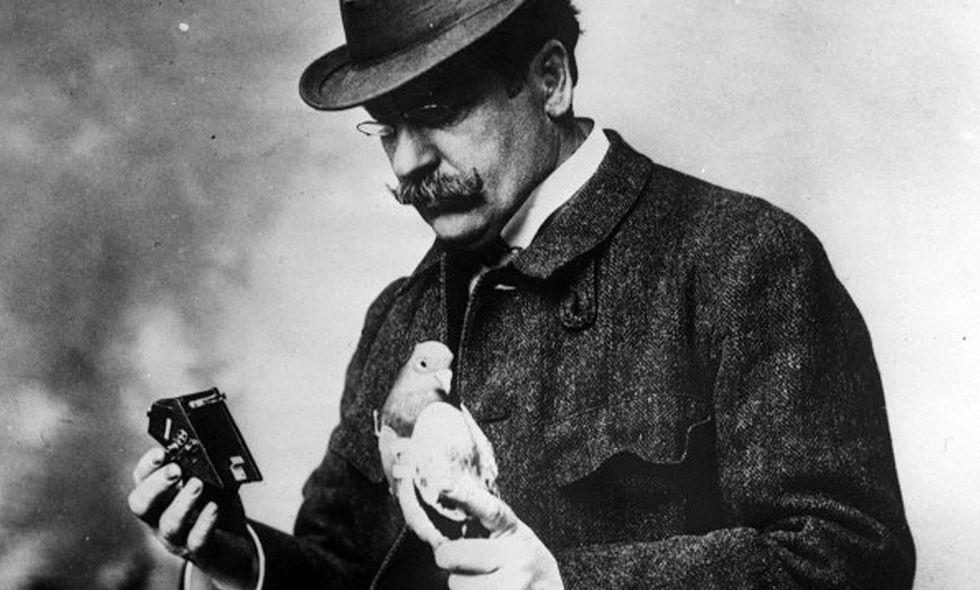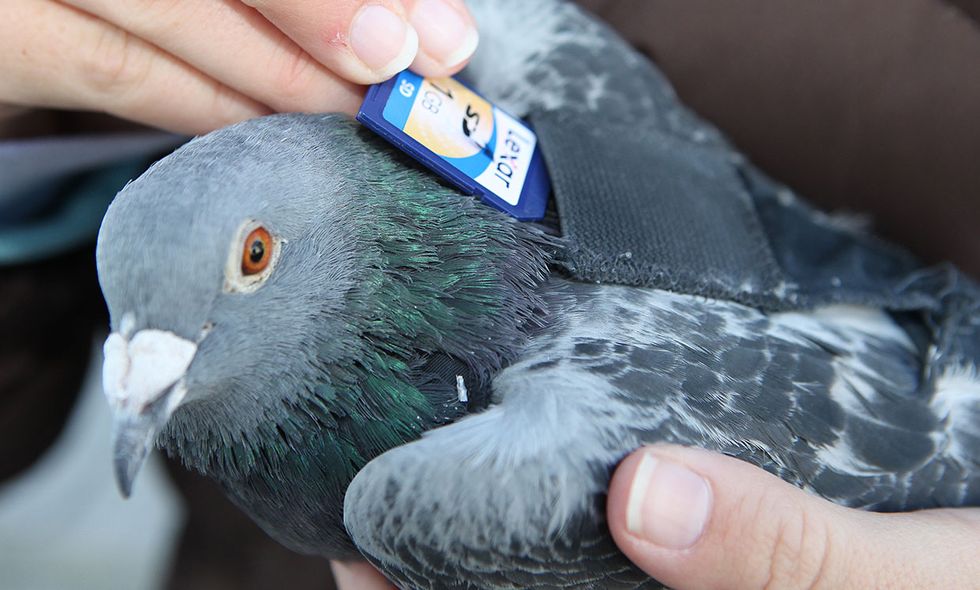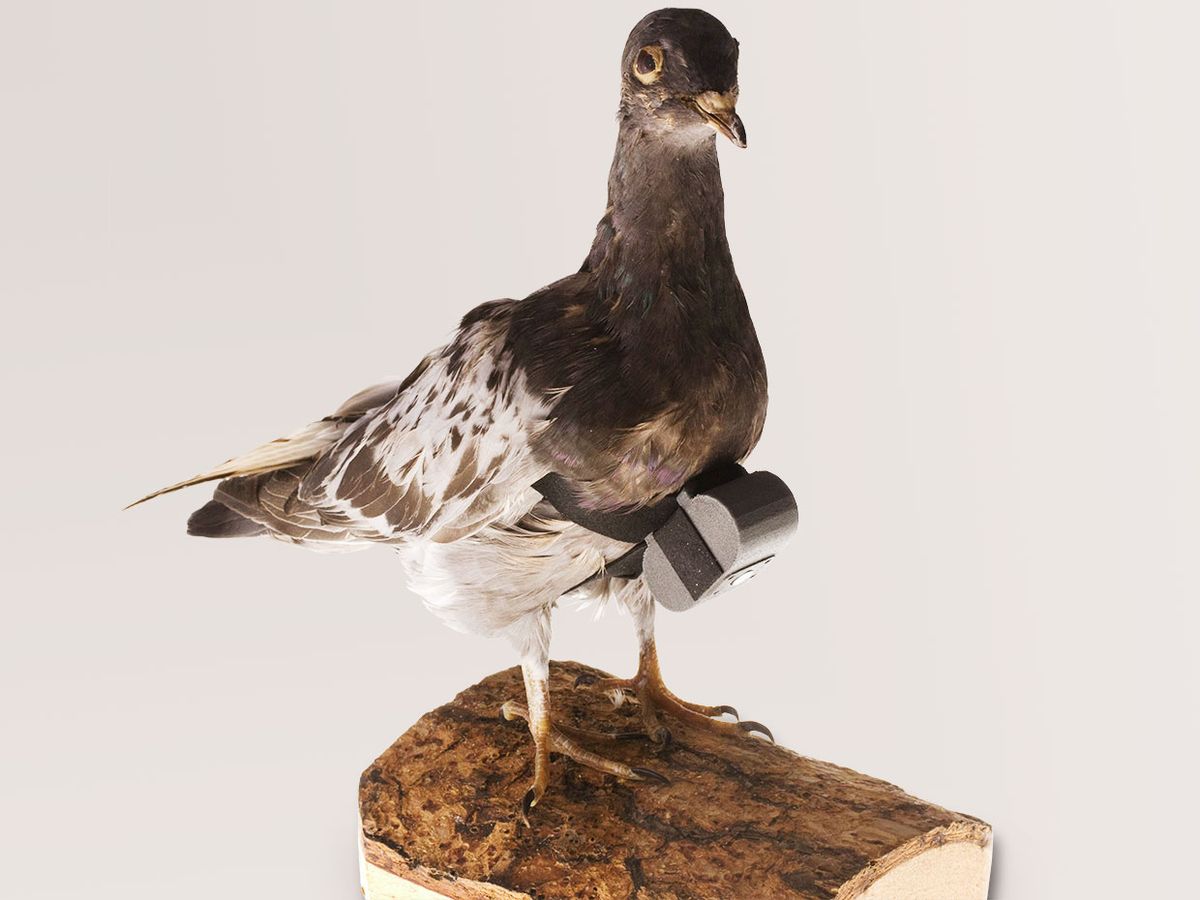For thousands of years, homing pigeons have been carrying messages. They proved especially useful during wartime. Julius Caesar, Genghis Khan, and the Duke of Wellington (at the Battle of Waterloo) are all said to have relied on bird-borne communications. During World War I, the U.S. Army Signal Corps and Navy maintained pigeon lofts. The French government awarded one U.S. bird, named Cher Ami, the Croix de Guerre for her valiant service during the Battle of Verdun. During World War II, the British maintained more than 250,000 homing pigeons, 32 of which were awarded the Dickin Medal, an honor bestowed on animals for wartime service.
Leave it to the U.S. Central Intelligence Agency to turn pigeons into spies. In the 1970s, the CIA’s Office of Research and Development created a small, lightweight camera that could be strapped to a pigeon’s breast. After release, the bird would fly over its intended target, en route to its home base. A battery-operated motor inside the camera advanced the film and clicked the shutter. With a flight path just a few hundred meters above the ground, the pigeon cam took significantly more detailed photos than images taken from aircraft or satellites. So was the CIA’s pigeon cam a success? We don’t know. Its files remain classified to this day.

The CIA was not the first to pioneer this technology. Julius Neubronner, a German apothecary, usually gets the credit as the first to train pigeons to take aerial photographs. In the early decades of the 20th century, Neubronner strapped cameras to the chests of his homing pigeons. A timer snapped a shot at regular intervals while the bird was in flight.
The Prussian military investigated using Neubronner’s pigeon cam for reconnaissance, but dismissed the idea because they couldn’t control the flight patterns or the specific shots that the pigeons took. Instead, Neubronner turned the images into postcards. These images are now collected in the 2017 book The Pigeon Photographer (Rorhof). Several shots are also available on YouTube:
The main reason that pigeons can be used for communication (or spying) is that they have a natural gift for magnetoreception—that is, they’re able to sense the earth’s magnetic fields to determine their location, direction, and orientation.
Early observers in ancient Egypt and Mesopotamia recognized that pigeons would usually return to their home roost, even when they were released far away. It wasn’t until relatively recently, though, that scientists began to understand how magnetic orientation in birds works [PDF].
In 1968, for example, the German zoologist Wolfgang Wiltschko described the magnetic compass in European robins (Erithacus rubecula), a migratory species. He observed that captive robins would congregate at one end of their cage, facing the direction in which they would otherwise be traveling. When Wiltschko manipulated magnetic fields within the lab using Helmholtz coils, the robins responded by shifting their orientation even though they had no visual or directional cues.
Assessing magnetoreception in homing pigeons was a bit more difficult because the birds had to be released in a natural setting in order to exhibit their distinctive behavior. Outside the lab, there was no easy way to control the magnetic fields, and it was tricky to know whether the birds were relying on other ways of navigating, such as the position of the sun.
In the 1970s, Charles Walcott, an ornithologist at the State University of New York at Stony Brook, and his student Robert P. Green devised a clever experiment that overcame these various difficulties. They started by training a flock of about 50 homing pigeons to fly in both sunny and overcast conditions on an eastward line, releasing them from three different locations.
Once the pigeons would reliably return home regardless of the weather, the scientists decked them out in fancy hats. They placed battery-operated coils on each pigeon—one coil encircled the bird’s neck like a collar while another coil was glued to its head. The coils could be used to manipulate the magnetic current around the bird.
The current had little effect when the birds were flying on sunny days. But when it was cloudy, the birds would fly either toward or away from home depending on the direction of the magnetic current. That finding suggests that on clear days, pigeons navigated by the sun, whereas on overcast days, the earth’s magnetic field was the prevailing force. Walcott and Green published their findings in Science in 1974.

Additional experiments and research honed the theory of magnetoreception, but to date, nobody has identified exactly where birds’ magnetoreceptors reside. In 2002, Wiltschko and his team suggested the right eye. But nine years later, Christine Hein, Svenja Engels, Dimitry Kishkinev, and Henrik Mouristen published a response in Nature, stating that they couldn’t replicate the result.
A second theory was the beak—specifically, iron deposits in the upper beak of some birds. That idea, too, was shot down, when in 2012 a team characterized those cells as macrophages, which are part of the immune system. A few months later, David Dickman and Le-Qing Wu suggested a third possibility: the inner ear. Discovering the nexus of avian magnetoreception remains an area of active research.
Luckily for those wanting to set up a pigeon-net, understanding how the birds know where to go isn’t important. You just have to train them to fly between two points. This is best done through the time-tested incentive of food. By feeding the birds in one location and housing them in another, you can teach the pigeons to fly the route. It’s also possible to train pigeons to return home from unfamiliar locations. In competitive races, the birds can travel up to 1,800 kilometers [PDF], although 1,000 km seems to be a more normal upper limit.
Throughout the 19th century, pigeons carried messages tucked inside small tubes strapped to their legs. Typical routes included islands to mainland cities, rural villages to city centers, and other places where telegraph wires had not yet connected communities.
A single pigeon could carry only a limited number of regular messages—it doesn’t have the carrying capacity of an Amazon drone, after all. But the invention of microfilm in the 1850s by French photographer René Dagron made it possible for each bird to carry many more words and even pictures.
A decade or so later, when Paris was besieged during the Franco-Prussian War, Dagron suggested that pigeons be used to deliver microphotographs for both official and private correspondence. Dagron’s pigeon post eventually delivered more than 150,000 microfilmed sheets, which collectively held about a million messages. The Prussians did catch on, employing hawks and falcons to try to catch the winged messengers.
During the 20th century, as regular postal, telegraph, and telephone service became more reliable, pigeon post fell to the domain of fanciers, hobbyists, and those with specialized needs.
In the mid-1990s, for instance, Rocky Mountain Adventures, a Fort Collins, Colo., rafting company, incorporated pigeons into its trips down the Cache la Poudre River. Film taken along the route would be loaded into tiny pigeon backpacks. The birds were released and returned to the company’s store. By the time the rafters got back to the store, the photos had been developed—souvenirs made that much more special by the pigeon post.

The birds made an uneasy transition to the age of digital cameras, according to a company spokesperson. Carrying SD cards instead of rolls of film, they had a tendency to head to the trees instead of their home roosts, perhaps because their load was so much lighter. The company finally retired its pigeons with the advent of the cellphone camera.
My brief survey of pigeon-based communication wouldn’t be complete without a mention of David Waitzman’s April Fool’s Day request for comments for the Internet Engineering Task Force. Released on 1 April 1990, RFC 1149 described the IPoAC—Internet Protocol over Avian Carriers—for carrying Internet traffic via pigeon. The update, released on 1 April 1999, noted both security considerations (“There are privacy issues with stool pigeons”) and patent considerations (“There is ongoing litigation about which is the prior art: carrier or egg”).
Real-life implementations of the IPoAC in Australia, South Africa, and the United Kingdom pitted live birds against admittedly spotty telecom service. The birds won. Even after thousands of years as a communication tool, the humble pigeon continues to hold its own.
An abridged version of this article appears in the April 2019 print issue as “Pigeon: Impossible.”
Part of a continuing series looking at photographs of historical artifacts that embrace the boundless potential of technology.
About the Author
Allison Marsh is an associate professor of history at the University of South Carolina and codirector of the university’s Ann Johnson Institute for Science, Technology & Society.
Allison Marsh is a professor in Women and Gender Studies at the University of South Carolina and codirector of the university’s Ann Johnson Institute for Science, Technology & Society. She combines her interests in engineering, history, and museum objects to write the Past Forward column, which tells the story of technology through historical artifacts. Marsh is currently working on a book on the history of women in electrical engineering.



